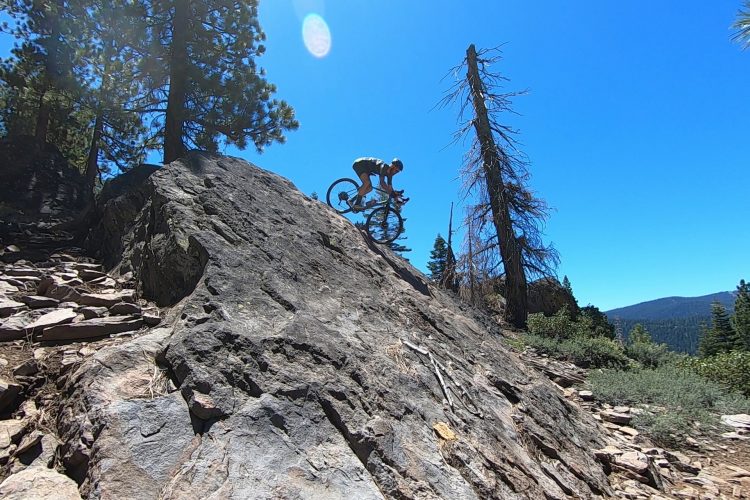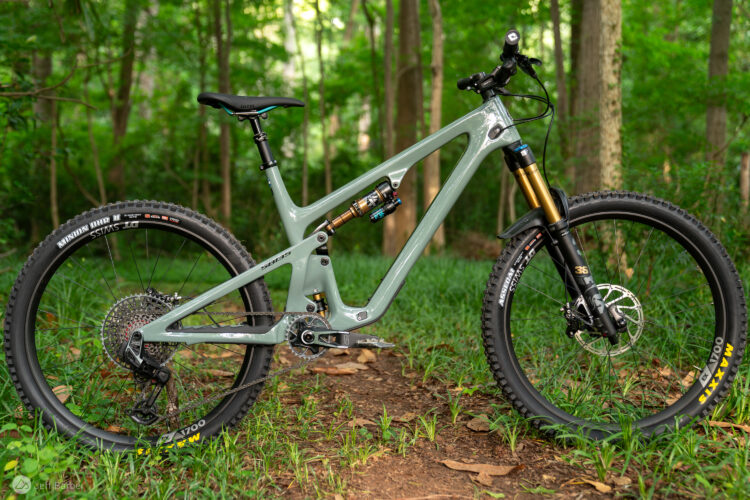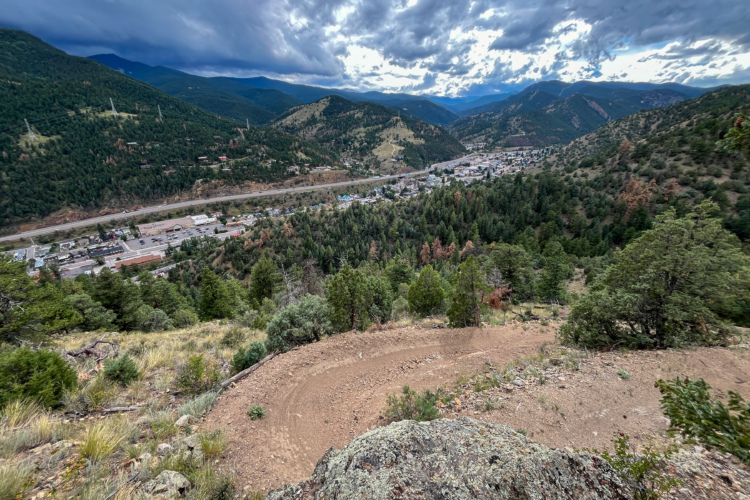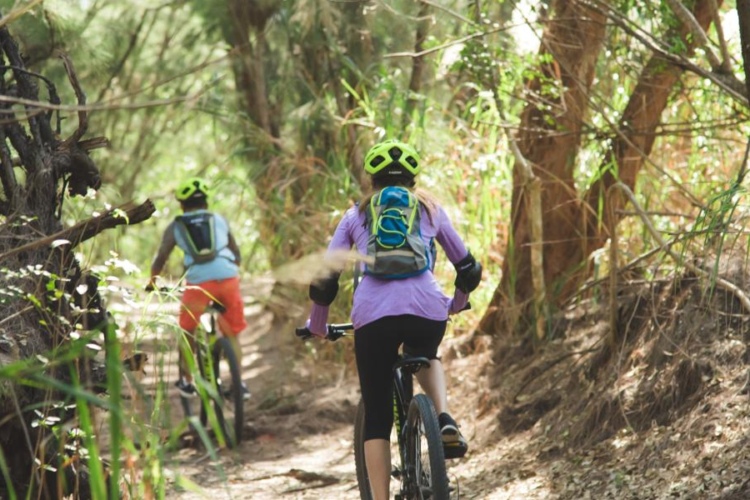
Today’s mountain bikers have never had it so good. Supple suspension, dropper posts, and long, slack, and low geometry have revolutionized the sport. The technology found in today’s mountain bikes give riders the comfort and confidence to ride gnarlier trails harder and faster than ever before.
Yet, there is a small group of riders who reject the modern version of mountain biking, instead favoring bikes that make riding harder. They are the riders who crave the experience of riding on the very edge of control, knowing their strength and skill will ultimately determine their success or failure. The ones who find both meaning and joy in suffering. They are the riders who engage in underbiking.
To better explain underbiking and why more riders should embrace it, I spoke to Jason Gainey, a mountain bike instructor with Fluidride and Jeremiah “Scratch” Stone, a professional trailbuilder and instructor with Ninja MTB Performance.

What is underbiking? It’s commonly defined by the limitations of the bike itself
Taking a gravel bike on singletrack or an XC bike on a jump trail are two examples of how most would define underbiking. They compare the bike to where it’s being ridden. If the bike is limiting the riding experience of the rider or making the ride more challenging, then it’s an underbike.
It’s how Singletracks Editor-in-chief Jeff Barber views underbiking. “A good way to know if you’re underbiked is if you feel like the bike, rather than your skills, are keeping you from going faster on descents.”
For Stone, there are various aspects of a bike that can make it an underbike. “It could be suspension or geometry, or it could be brakes, drivetrain, or an entirely different flavor or era of bike. In my eyes, singlespeeding is a version of underbiking. Mechanical brakes, static seatposts, and any handlebar less than 760mm fits the category in my overbuilt mind these days as well!”

But defining underbiking isn’t that simple according to Gainey
Gainey thinks underbiking is more complex than just riding a less-capable bike on difficult trails. For example, Gainey said that racing enduro on a bike with enduro geometry but less suspension travel isn’t really underbiking. “Even with less suspension travel, the bike won’t get me into trouble because of its geometry.”
Gainey views underbiking as riding a bike with a shorter wheelbase, steeper head angle, and shorter reach. He puts riding vintage mountain bikes, singlespeed mountain bikes, and gravel bikes into their own separate categories.
Gainey’s definition makes sense because it focuses on the way a rider must handle a bike based on its geometry instead of just focusing on certain components of the bike or the way the bike feels on certain sections of a trail.

Riders who engage in underbiking are more likely to progress their skills
In Gainey’s opinion, underbiking as he defines it, helps riders become better on the bike. “Bigger bikes might save newer riders from their mistakes, but they are not getting the body position benefits from them. It hurts their ability to progress their skills.” Gainey says that underbiking forces riders to slow down and work on their skills because there is less of a safety net if they make a mistake.
Stone also agrees underbiking can benefit newer riders in certain circumstances. “In forgiving terrain, underbiking can be a really good way for new riders to fall in love with the sport. Learning to move your body well will do more for your riding than any amount of suspension setup. Plus, the thrills are more available. There’s a feeling of power when you ride a short travel bike or a hardtail aggressively well, and that’s the sensation a lot of riders fall in love with.”

But underbiking has its drawbacks too
Underbiking might look cool, but it’s also physically demanding. Riders need a lot of strength, conditioning, and aerobic capacity to constantly maneuver underbikes on a trail. As Barber pointed out, “it’s [also] more difficult to keep up with friends who are on proper bikes for the trail and could be frustrating if it means walking a lot of sections.”
Plus, underbiking can take a toll on both the bike and its rider’s body. As Stone told me, “The biggest disadvantages I find to underbiking have got to be the wear and tear on both the machine and my body. When I ride underbiked, I’m much rougher on components. This usually manifests in multiple shock rebuilds throughout the season, and occasional dented or cracked rims. I also feel significantly more knee pain when I underbike.”
And riders who crave speed will not be happy underbiking. Gainey mentioned that a bike with a shorter reach and steeper head angle will force riders to slow down and focus more on their movement on the bike.

Yet underbiking gives riders a more satisfying experience
Underbiking gives riders experiences that today’s modern trail bikes can’t. According to Stone, underbikes are “oftentimes lighter, which can make a big difference in low-speed technical trails or climbing, and even cornering. A slightly shorter wheelbase and steeper angles make these bikes easier to maneuver tightly.” Personally, I love being able to sprint away from others while climbing on my singlespeed bike. It gives me joy seeing the look of utter confusion on their faces.
Stone is a firm believer that mountain biking should be fun, and, to him, underbiking is a blast. “Underbiking can be many, many things, and I’m here for the experience! In my mind, underbiking is just one of many strategies to help us have more fun on bikes, and I’ll always support that! The challenge of adapting to mechanical differences is interesting to me, and adding to that the decisions we make while riding such as speed and line choice can be a very entertaining process to both experience and observe.”
Let’s face it, it’s more satisfying to complete a ride knowing your skills made the difference instead of the bike you were riding. That’s why underbiking is so rewarding.

Underbiking is the uncomfortable way to grow as a rider
As Arlin Cuncic stated in a recent article, “[b]eing uncomfortable is good for you because we must be uncomfortable in order to grow and learn.” Modern trail bikes make riders too comfortable at times. They are specifically designed to save riders from their mistakes, often making us think we are better riders than we really are.
Underbiking does the opposite. It makes riders uncomfortable and exposes their weaknesses. Make the wrong line choice and you’ll crash. That sucks, but it’s also a powerful learning tool. Most people have an aversion to pain, so, when they get hurt, they try not to repeat the same behavior that caused them pain. I fell a lot when I first started mountain biking, and each fall taught me a valuable lesson that made me the rider I am today.
If you’re content with being the rider you are today then keep doing what you’re doing. But if you want to grow as a rider then you need to get out of your comfort zone and embrace the suck of underbiking.









